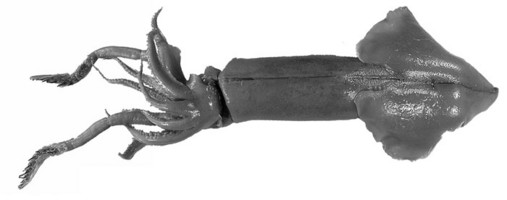Onychoteuthis bergii
K.S.R. BolstadIntroduction
Onychoteuthis bergii is the type species of the genus. It was thought, until recently, to be a junior synonym of O. banksii, but examination of the type material (lectotype and paralectotype belonging to the Zoologisches Musuem, Museum für Naturkunde der Humboldt-Universität, Berlin), revealed morphological differences that suggest the validity of O. bergii.
Characteristics
- Photophores
- Two circular intestinal photophores present. Anterior photophore diameter 60-70% that of posterior photophore.
- Ocular photophore a long whitish patch on ventral surface of each eyeball.
- Measurements of lectotype
- Mantle length - 126 mm
- Arm lengths - 38-51 mm
- Fin length - 71 mm
- Fin width - 81 mm
- Club length - 31 mm (L)
- Club hooks - 23
- Largest hooks - Hooks V7 and V8
- Smallest mid-series dorsal hooks - Hooks D4 and D5, or D5 and D6
- Tentacle club
- Length ~25% ML, with 21–23 hooks.
- Distal-most ventral hook bases produced into low, rounded spike.
Comments
(from Bolstad 2010) "The type specimens of O. bergii resemble specimens of similar sizes attributed to O. banksii in many regards; the ocular and intestinal photophores are of similar shapes and relative sizes, and the club lengths and overall body proportions are similar. The chromatophores on the O. bergii types are greatly faded, so their distribution is uncertain, and the tentacular hooks appear somewhat shrunken and deformed, prohibiting direct comparison of these characters. However, certain differences between the O. bergii types (and other material attributed to O. bergii) and O. banksii specimens are consistent: where the posterior portion of the mantle in O. banksii is consistently tapered, even in maturing specimens, in O. bergii it remains widely conical even toward the posterior extremity in specimens of ML 92–144mm [see illustration below]; the lower beak proportions are different, with the LRL longer relative to the wing length in O. banksii than in O. bergii; the largest ventral tentacular hooks in O. bergii appear more robust, shorter relative to club length and longer relative to paired dorsal hook length than those in O. banksii; and the ventral bases of the distal-most ventral hooks in O. banksii are are not produced into a spike, while those in O. bergii do develop a small spike."
References
Bolstad, K.S. 2010. Systematics of the Onychoteuthidae Gray, 1847 (Cephalopoda: Oegopsida). Zootaxa, 2696: 186pp.
Title Illustrations

| Scientific Name | Onychoteuthis bergii |
|---|---|
| Location | Cape of Good Hope |
| Specimen Condition | Dead Specimen |
| Sex | Female |
| View | Dorsal |
| Size | ML 126 mm |
| Collection | Zoologisches Museum, Berlin |
| Type | Lectotype |
| Collector | Bergius |
| Copyright |
© K.S.R. Bolstad

|
| Scientific Name | Onychoteuthis bergii |
|---|---|
| Specimen Condition | Dead Specimen |
| View | Dorsal |
| Copyright |
© 2010 K.S.R. Bolstad

|
About This Page
K.S.R. Bolstad

Auckland University of Technology
Correspondence regarding this page should be directed to K.S.R. Bolstad at
Page copyright © 2019 K.S.R. Bolstad
All Rights Reserved.
- First online 23 December 2010
- Content changed 11 October 2015
Citing this page:
Bolstad, K.S.R. 2015. Onychoteuthis bergii . Version 11 October 2015 (under construction). http://tolweb.org/Onychoteuthis_bergii/145218/2015.10.11 in The Tree of Life Web Project, http://tolweb.org/












 Go to quick links
Go to quick search
Go to navigation for this section of the ToL site
Go to detailed links for the ToL site
Go to quick links
Go to quick search
Go to navigation for this section of the ToL site
Go to detailed links for the ToL site